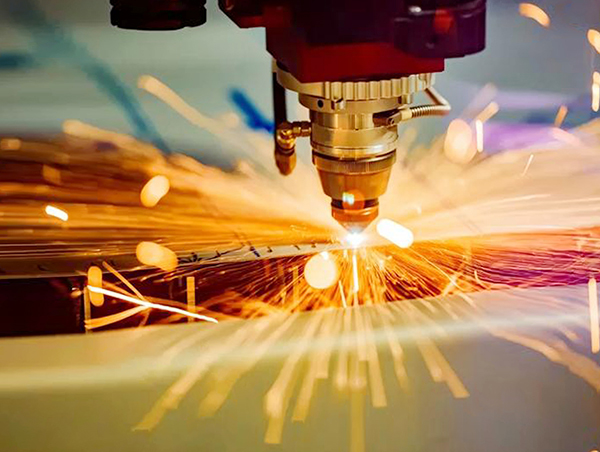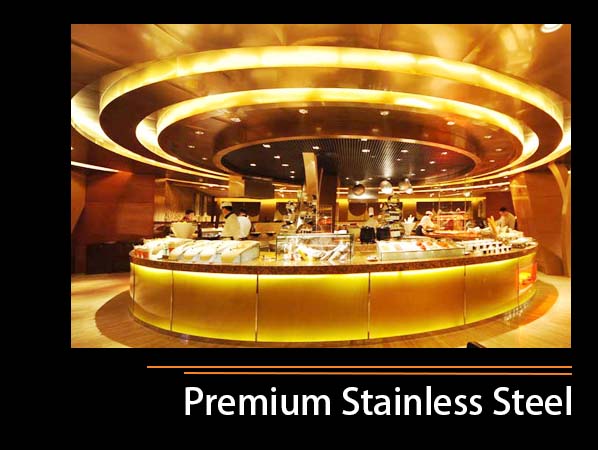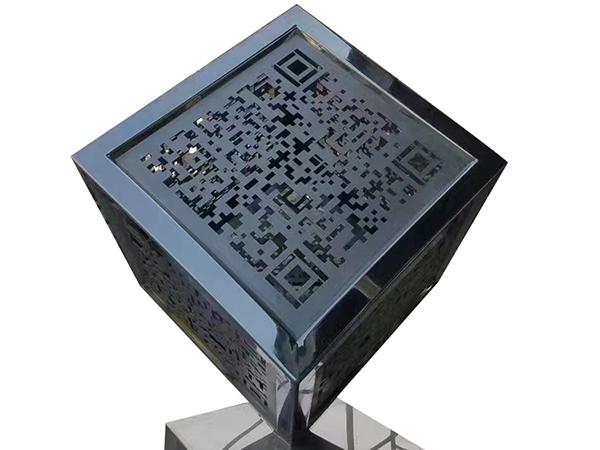
The Cutting Methods of Stainless Steel
There are many methods to cut stainless steel, mainly divided into mechanical cutting and thermal processing cutting. Mechanical cutting mainly includes shearing, punching, wire EDM, drilling and milling machines, etc. Different mechanical cutting methods are selected according to the different thicknesses and shapes of stainless steel sheets. Thermal processing cutting mainly includes laser cutting, plasma cutting, oxidation cutting, etc. Laser cutting is suitable for thin stainless steel sheets, plasma cutting is suitable for medium-thick plates, and oxidation cutting is mainly used for thick plates.
Now we will see the difference each.
1. High Pressure Water Jet Cutting
This new technology uses a 0.80-1.50mm jet of water with speed of
600-800 meters/second (speed greater than Mach 2). The water pressure is 3000
to 4000 bar, and the water consumption is only 4 liters per minute.
To cut stainless steel with abrasives such as aluminum oxide or
silicon carbide, abrasive particles are injected into the water jet before it
reaches the steel. Modern equipment can cut 20.0mm thick stainless steel. The
cutting edge is accurate and the cutting surface is clean and smooth.
The heat generated by the cutting action is taken away by the water, and the metal temperature is only 50 to 60°C. This, coupled with the force generated by the jet water on the metal, can prevent deformation and improve cutting accuracy.
2. Step-By-Step Punching
This process uses round and triangular punches to punch a series of overlapping holes. It is obviously not possible to make a perfectly smooth cut with this process, but by using good tool design and overlapping the cuts, the cut edge can be made satisfactory for most purposes. Portable stepper blanking machines are usually used to cut carbon steel sheets. If used to cut austenitic stainless steel, 60% more force is required. Also, reduce the maximum thickness that the machine can cut. The processing plant's machines can punch at least 8mm stainless steel. Modern machines can also use a combination of shearing and punching to produce the required blanks.
3. Guillotine Scissors
Most processing plants use this type of hand-operated shear. The
blade length of this type of shear can reach 3m, but if the end of the shear is
open, continuous shearing can be used to obtain a cut longer than the shear
blade. But be careful not to cut out steps.
Since shearing stainless steel requires a large power, the
thickness that the shear can cut when shearing mild steel must be reduced by
two wire gauges when shearing ferritic steel, and when shearing austenitic
stainless steel to reduce the wire gauge number by 4. Therefore, a shear
capable of cutting 2mm mild steel should be reduced to less than 1.6mm when
shearing ferritic steel and less than 1.2mm for austenitic steel, and the
cutting blade gap also needs to be reduced accordingly. Typical cutting edge
clearance value for stenitic stainless steel is 5%.
Most processing plants know the importance of firmly clamping the steel sheet and keeping the blade in good condition during the shearing process. However, people who are new to stainless steel may not know that in order to prevent contamination of the stainless steel surface, they need to work on a guillotine shear. Place protective pads on the table or other places in contact with carbon steel. If the guillotine shear also cuts carbon steel, it is best to check the blade before cutting stainless steel to remove carbon steel particles that may adhere to and contaminate the stainless steel.
4. Disc Shears
Disc shears work on the same basic principle as guillotine shears, but by using a disc blade they can make continuous cuts. Steel mills use several blades mounted on two shafts to slit wide steel coils. However, a pair of blades can also be used to cut a single straight strip. Some shears can also move the blade sideways to cut wedge-shaped blanks during the shearing process, while others can rotate the cutter to cut round blanks.
5. Saw
Although bow saws and band saws can be used to cut narrow sheets,
these two saws are typically used to cut medium-thick sheets, steel sections,
and tubes.
Austenitic stainless steel will harden by cold work, so friction is strictly prohibited. This is very important and must be paid attention to. Therefore, the saw needs to be lifted on the return stroke. The high-speed saw blade has 8 to 10 teeth per inch when sawing thick materials, and 24 to 32 teeth per inch when sawing thin sheets and pipes. When cutting austenitic stainless steel by motor, it can cut at 50/80 times per minute. For ferritic stainless steel, the cutting speed is 100/200 times per minute. When cutting on a conventional band saw, use sharp teeth at low speeds and even small feeds to keep the blade cutting.
6. Abrasive Cutting
This method uses a high-speed rotating grinding wheel to cut
steel. Grinding discs are made of abrasive materials bonded with fiber, resin
or rubber. In skilled hand operation, the grinding wheel makes quick, accurate
cuts that are neat and burr-free. Grinding wheels only allow you to make
straight cuts, but this is sufficient for most purposes.
Grinding wheels are often used to cut
pipes. Processing plants also use grinding wheels to grind long grooves.
On-site repairs typically involve a hand-operated grinder. However, a large amount of dust and "steel chips" are generated when using a hand-operated grinder, so dust removal or protection devices are required. The grinders used in production plants are generally equipped with a cooling system, which can not only reduce dust but also prevent damage to the material. Cause thermal damage.
7. Laser Cutting
This technology uses the energy released when a laser beam hits
the surface of the steel sheet to melt and vaporize the stainless steel. The
laser source generally uses a carbon dioxide laser beam with a working power of
500 to 3000 watts. This power level is lower than that required by many
household electric heaters, but the laser beam is focused on a small area
through lenses and mirrors. The high concentration of energy enables rapid
localized heating to vaporize stainless steel. In addition, because the energy
is so concentrated, only a small amount of heat is transferred to other parts
of the steel, resulting in little or no deformation. Lasers can be used to cut
complex-shaped blanks very accurately, and the cut blanks do not need to be
further processed.
Laser cutting equipment can cut stainless steel below 4 mm. Adding
oxygen to the laser beam can cut stainless steel 8 to 10 mm thick. However,
after oxygen cutting, a thin oxide film will be formed on the cutting surface.
The maximum thickness of cutting can be increased to 16mm, but the size error
of the cutting parts is larger.
Laser cutting equipment is quite expensive. However, due to the reduced cost of subsequent processing, it is still feasible to use this equipment in large-scale production. Since there are no tool processing costs, laser cutting equipment is also suitable for producing small batches of parts of various sizes that could not be processed previously. Currently, laser cutting equipment usually uses computerized numerical control (CNC) devices, which can use telephone lines to receive cutting data from a computer-aided design (CAD) workstation.
8. Plasma Arc Cutting
This method is to pass the mixed gas through a high-frequency arc.
The gas can be air or a mixture of hydrogen, argon and nitrogen. The
high-frequency arc causes some gases to "decompose" or ionize into
basic atomic particles, thereby producing "plasma". Then, the arc
jumps to the stainless steel workpiece, and the high-pressure gas blows the
plasma out of the cutting torch burner with an exit speed of 800 to 1,000
meters per second (about Mach 3). In this way, the high energy released when
the various gases in the combined plasma return to their normal state produces
a high temperature of 2700°C. This temperature is almost twice the melting
point of stainless steel. As a result, the stainless steel is quickly melted,
and the molten metal is blown away by the jet of high-pressure air. Therefore,
smoke exhaust and slag removal equipment are required.
This method can be used to cut stainless steel with a thickness of 3.0~80.0mm. The cut surface is oxidized and due to the characteristics of the plasma, the cut takes on a figure-eight shape.
9. Manual Cutting
Using a conventional manual shear, if the cutting edge is sharp,
stainless steel below 0.9mm can be cut. However, due to the short length of
each shear, the steel sheet is prone to curling during the shearing process,
and the quality of the trimmed edges is poor. Unless the requirements for the
appearance of the trimmed edges are not high or the uneven trimmed edges do not
hinder the next process (such as making it difficult to align the welds, etc.),
it is not recommended to use manual shears for shearing.
How to Bend Stainless Steel Sheets?
Ø Mechanical bending method:
Use a bending machine and mold to bend the stainless steel sheet into the
required shape. This method is suitable for high-volume production and high
repeatability, but it requires specialized machines and tools and is more
expensive.
Ø Manual bending method:
Use hand tools, such as pipe benders, elbows, sheet bending machines, etc., to
manually bend stainless steel sheets into the required shape. This method is
suitable for small batch production and personalized customization, but
requires skilled technology and experience.
Ø Hot bending method: After
heating the stainless steel sheet to a certain temperature, use machinery or
hand tools to bend it into the required shape. This method is suitable for
larger thickness stainless steel sheets, but requires special thermal
processing equipment and technology.
Ø Laser bending method: Use a
laser cutting machine and a bending machine to cut the stainless steel sheet
into the required shape first, and then use a bending machine to bend it into
the required shape. This method is suitable for situations with high precision
requirements, but requires special laser equipment and technology.






